A Yew Tree of Brilliant Fire: Instruction Books for Fireworks

Hirayama (Japanese, active Yokohama, late 19th century). Catalogue of Fire-works, 1883. Drawings in watercolor; 8 1/4 x 7 1/16 x 3/8. The Metropolitan Museum of Art, New York, Gift of Lincoln Kirstein, 1968 (68.700.1)
«When we think of fireworks, we normally think of the cascading peonies and chrysanthemums that fill the night skies every year on the Fourth of July. But what about "ducks and dodecahedrons," "globes which leap or roll on the ground," or "a yew tree of brilliant fire"? Recreational and celebratory fireworks have been staged for centuries and range from the simplest forms to the most extravagant constructions, like the one shown in this 17th-century German description of fireworks staged in and around Munich.»
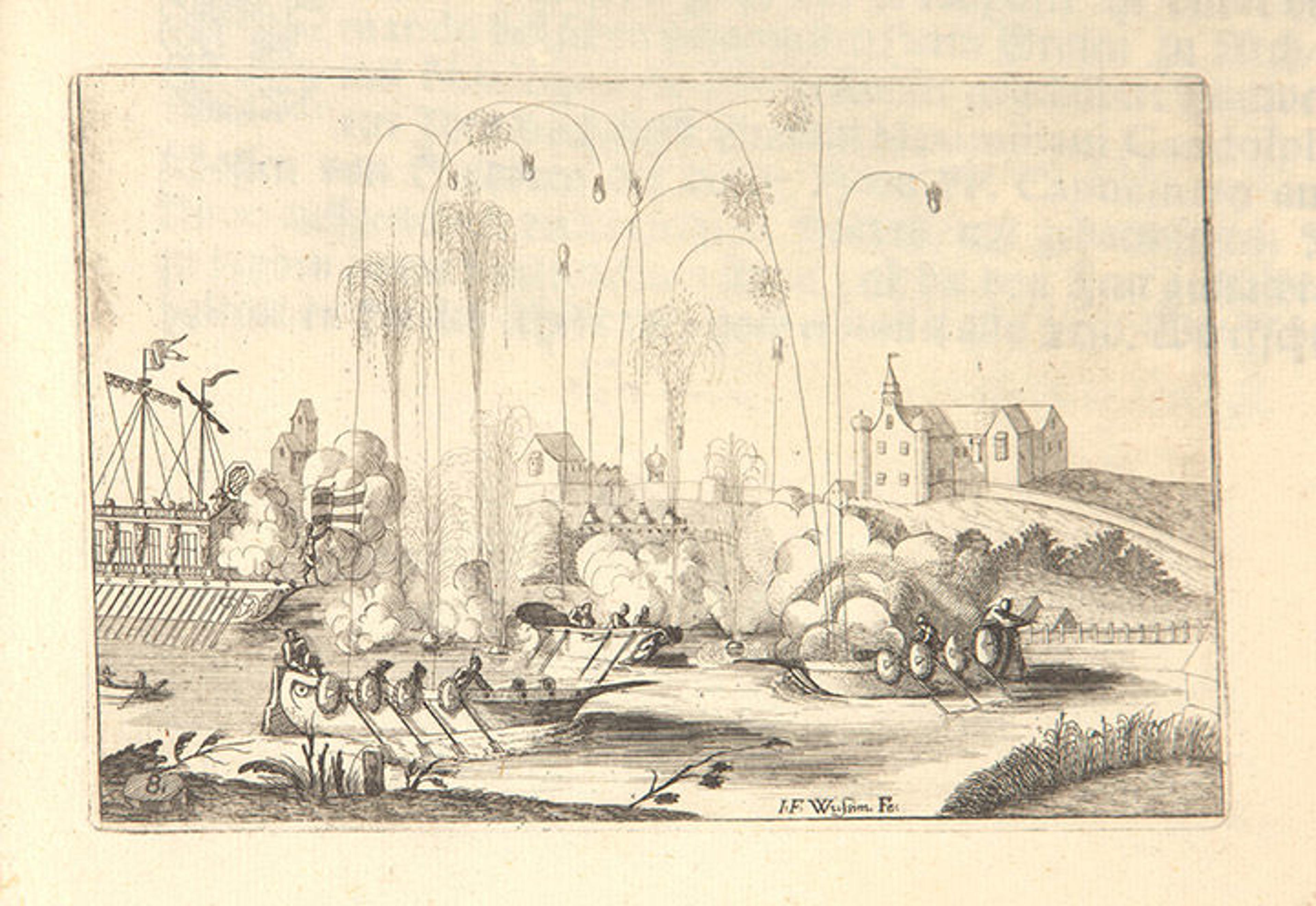
Written by Christoph Helle (German, 1662–85); Engraver: Johann Franz Wussin (German, active 1663–1701). Abbildung und Beschreibung von Feuerwerken in Munchen und Ungebung (Fireworks in and around Munich), 1662–82. Engraving; 7 11/16 x 12 5/8 x 7/16 in. The Metropolitan Museum of Art, New York, Harris Brisbane Dick Fund, 1946 (46.126.2)
The Sherman Fairchild Center for Book Conservation at Thomas J. Watson Library recently completed a project made possible by a grant from the New York State Program for Conservation and Preservation of Library Materials. We conserved a group of 150 "how-to" books from the Department of Drawings and Prints, which included nineteen publications devoted to fireworks published in seven countries over a span of four centuries. Here are a few highlights in honor of the Fourth of July.
For centuries, fireworks have made it seem as if the sun were shining at night, sometimes literally. Robert Jones's book Artificial Fireworks, Improved to the Modern Practice from the Minutest to the Highest Branches includes instructions and a diagram for building a "fixed sun with a transparent face." The 1747 French manual by François Frezier shown below illustrates a similar sun-like mechanism, partially illuminated.

Left: Author: Captain Robert Jones (British, 18th century); Engraver: William Darling (British, active 18th century). Artificial Fireworks, Improved to the Modern Practice from the Minutest to the Highest Branches, 18th century. Illustrations: engraving; 8 7 16 x 5 1/8 x 13/16 in. The Metropolitan Museum of Art, New York, Rogers Fund, 1966 (66.570.2). Right: Written by Amédee François Frezier (French, 1682–1773). Traité des Feux d'Artifice pour le Spectacle, 1747. Engraving; Overall: 7 11/16 x 5 1/8 x 1 9/16 in. The Metropolitan Museum of Art, New York, Harris Brisbane Dick Fund, 1942 (42.28.1)
The plate from Gerold's Viennese fireworks below illustrates a fully lit firework with a smiling face at its center.
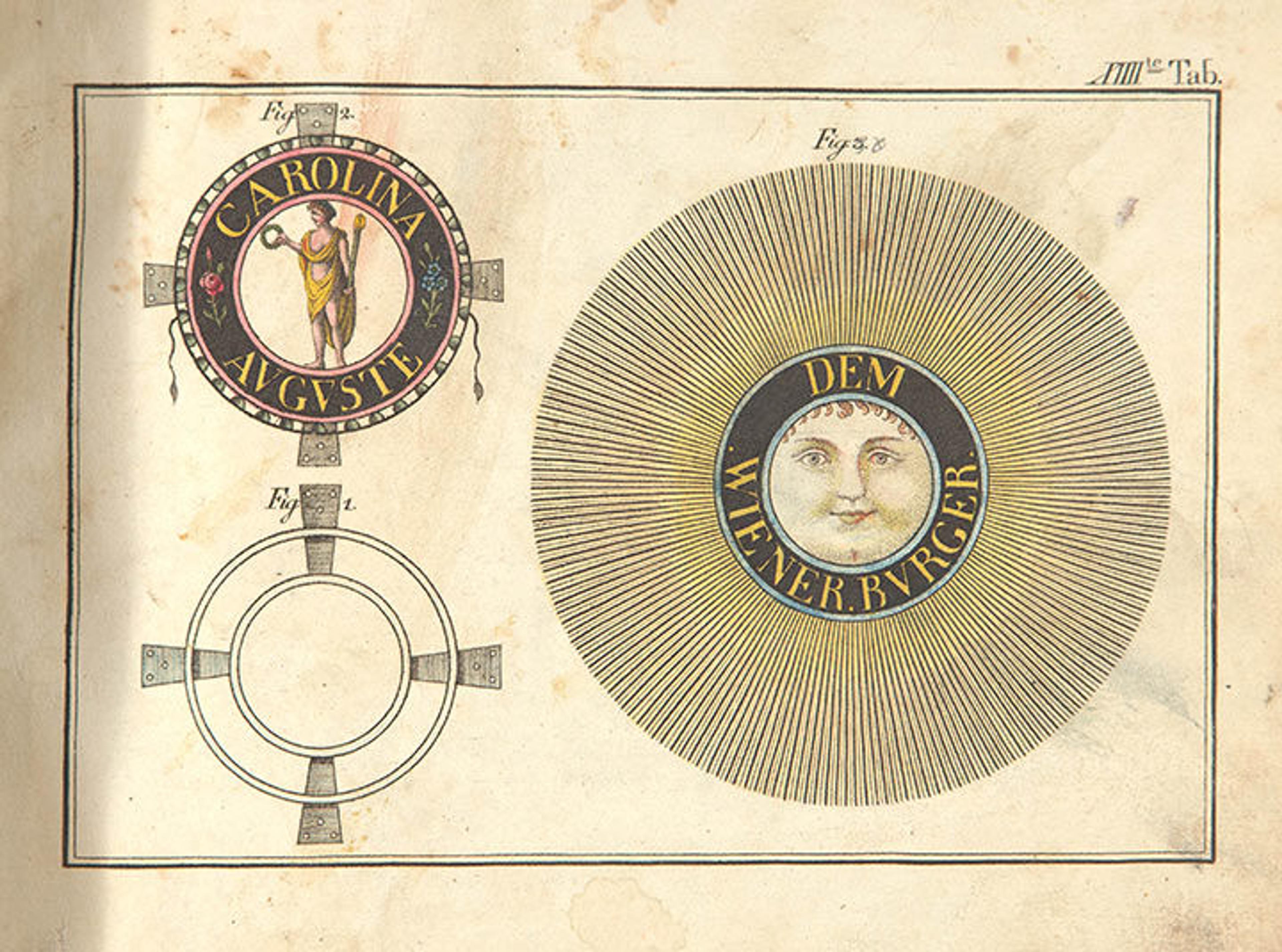
Published by Carl Gerold, Vienna. Dreyssig Illuminirte Kupfertalfeln zum Wiener Kunst - und Luftfeuerwerker, 1818. German. Hand-colored etchings; 7 11/16 x 9 5/8 x 3/8 in. The Metropolitan Museum of Art, New York, Harris Brisbane Dick Fund, 1948 (48.41.2)
Though fireworks are generally used after dark, this 1883 catalogue of Japanese daylight fireworks shows that the backdrop of the night sky is not a requirement for an amazing display.
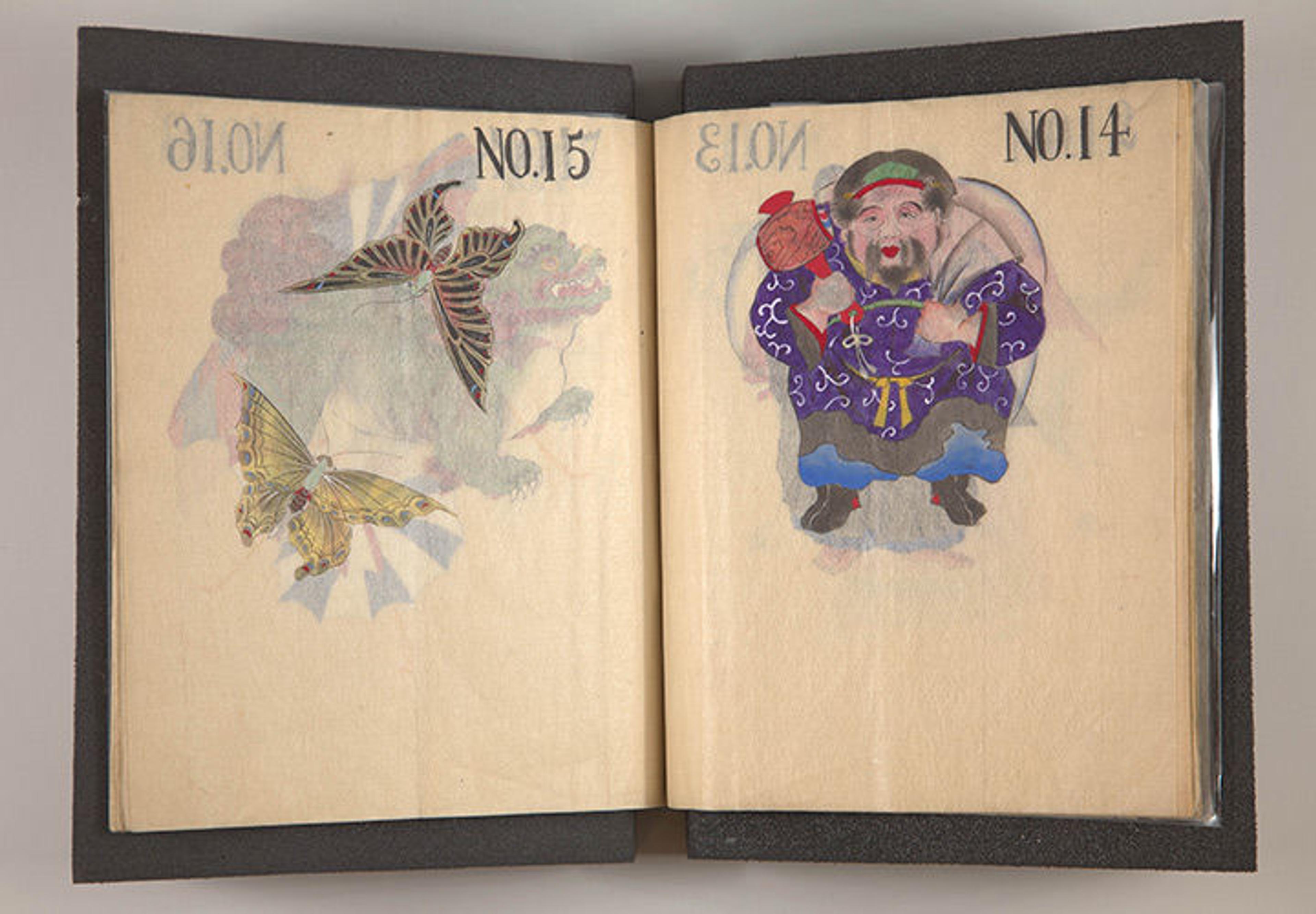
Hirayama. Catalogue of Fire-works, 1883. (68.700.1)
These hand-drawn watercolor designs for fireworks, fire balloons, and bombshells (as they are described in an American version of the catalogue) are on a lightweight Japanese paper folded on the fore-edge, and are so transparent that one can see the ghost image of the other side. These pages received minor cleaning, mending, and flattening. Fortunately, the stab-sewn binding was intact, so it can now be safely handled.
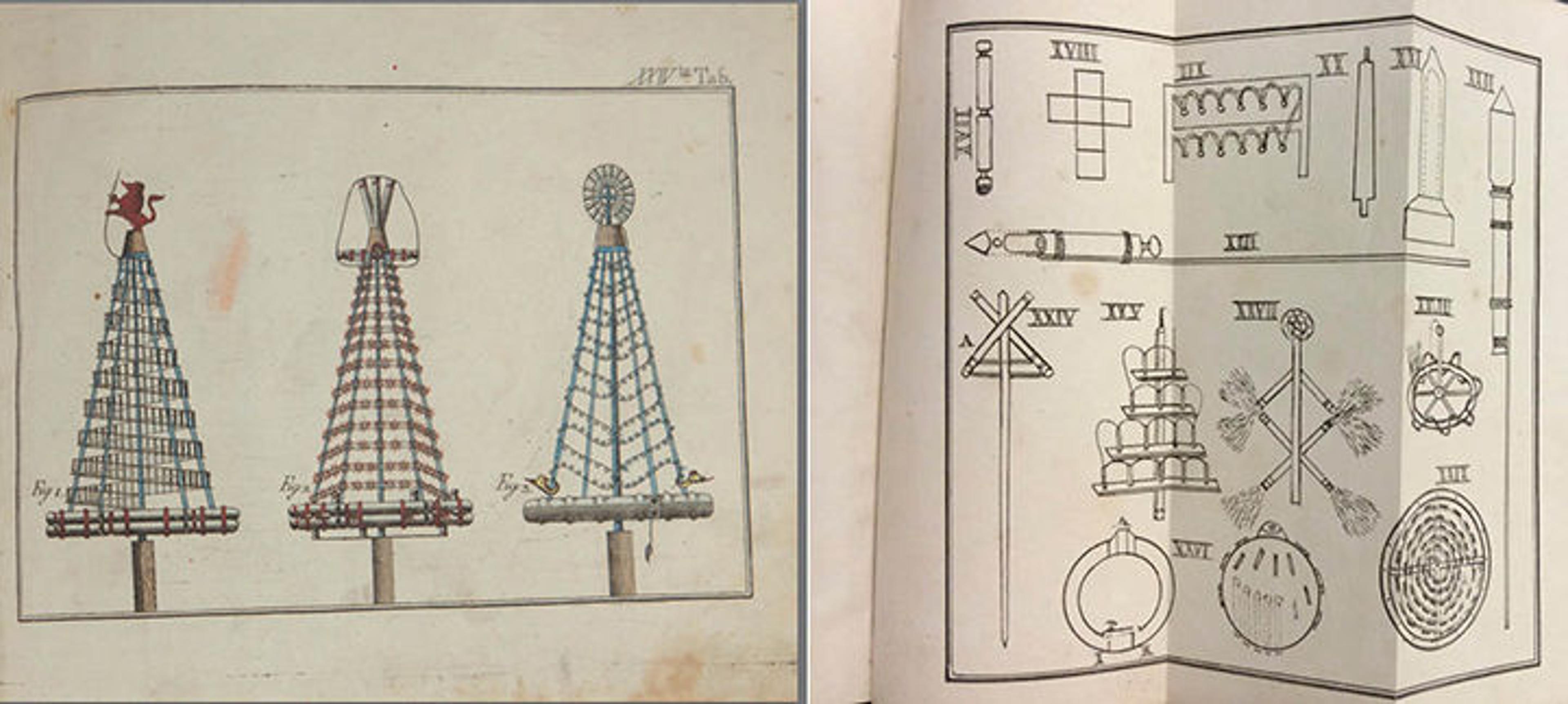
Left: Carl Gerold. Dreyssig Illuminirte Kupfertalfeln zum Wiener Kunst - und Luftfeuerwerker, 1818. (48.41.2). Right: Author: G. W. Mortimer (British, 19th century). A Manual of Pyrotechny; or, A Familiar System of Recreative Fire-Works, 1824. Illustrations: etching; 7 11/16 x 4 1/2 x 1/2 in. The Metropolitan Museum of Art, New York, Myra Carter Church Fund, 1958 (58.545.2)
Tree forms were another popular mechanism for displaying fireworks. Illustrated instructions for building a "Yew tree of brilliant fire" (or an "Illuminated yew tree"), "Fire-Tree,"and "Palm-Tree" appear in several manuals, including the 19th-century Fireworks and How to Make Them, which also shows two tree displays on its cover.

Publisher: George Poutledge & Sons (London). Fireworks and How to Make Them (front cover, before and after treatment), 19th century. Illustrations: etching; 6 11/16 x 4 1/8 x ¼ in. The Metropolitan Museum of Art, New York, The Elisha Whittelsey Collection, The Elisha Whittelsey Fund, 1967 (67.814)
This booklet received treatment on its spine and top corner. The conservator used colored paper matching the original printed paper-covered boards. Though still in relatively good condition, the book had obviously been used. The absence of any telltale burns seems to indicate that its owner managed to avoid the potentially incendiary "ignorant or foolhardy conduct" of which the book's unnamed author gave warning!
And what better way to display pyrotechnics than in the form of a dragon? These fire-breathing creatures appear in the Japanese daytime fireworks catalogue, as well as in a German manual, where it seems less a model than a mascot.
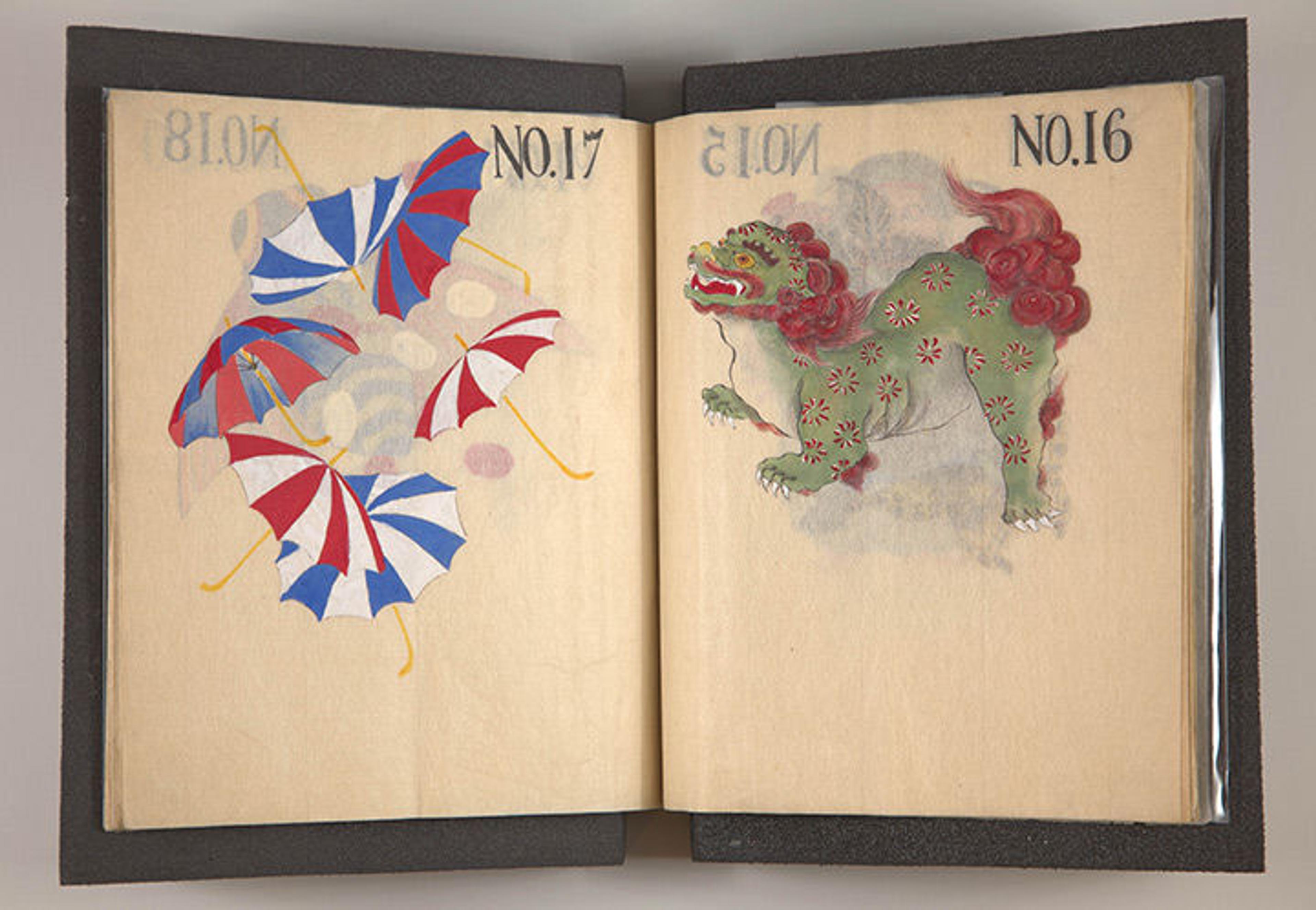
Hirayama. Catalogue of Fire-works,1883. (68.700.1)
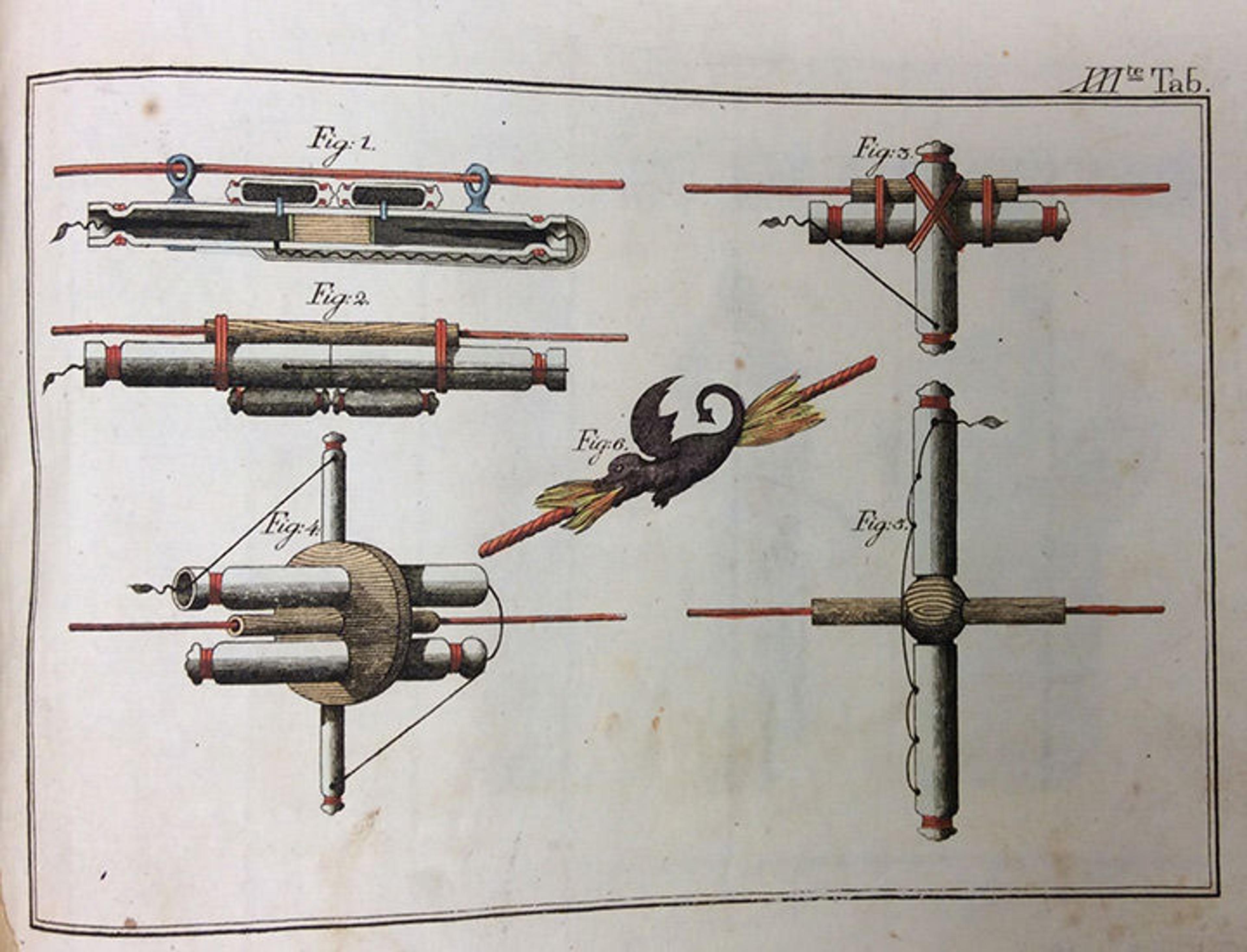
Carl Gerold. Dreyssig Illuminirte Kupfertalfeln zum Wiener Kunst - und Luftfeuerwerker, 1818. (48.41.2)
Pyrotechnia, shown below, provides instructions for building several fire-breathing dragons, including one that uses its fire to propel itself on wheels along a suspended line, which must have been a breathtaking spectacle. Firework designs such as this one impress with the ingenuity that was involved in the development of these sky-high celebrations. Thanks to the historic authors, illustrators, and publishers who chose to record this ephemeral art form, they can still serve as an exciting source of inspiration for our biggest firework spectacles.

Author: John Babington (British, active 1635); Egraver: Titlepage engraved by John Droeshout (British, active 17th century). Pyrotechnia or a Discourse of Artificial Fire-Works, A Short Treatise of Geometrie, 1635. Illustrations; engraving; 11 1/4 x 7 11/16 x 1 1/4 in. The Metropolitan Museum of Art, New York, Gift of Philip Hofer, 1952 (52.506.2)
Related Links
In Circulation: Dan Lipcan, "Celebrating the Super Bowl with Super Bowls" (February 3, 2016)
In Circulation: Ross Day, "Oh Say, Can You See . . . Hot Dogs!" (July 1, 2015)
Sophia Kramer
Sophia Kramer is an assistant book conservator in the Thomas J. Watson Library.
Cara Schlesinger
Cara Schlesinger is a volunteer in the Thomas J. Watson Library.